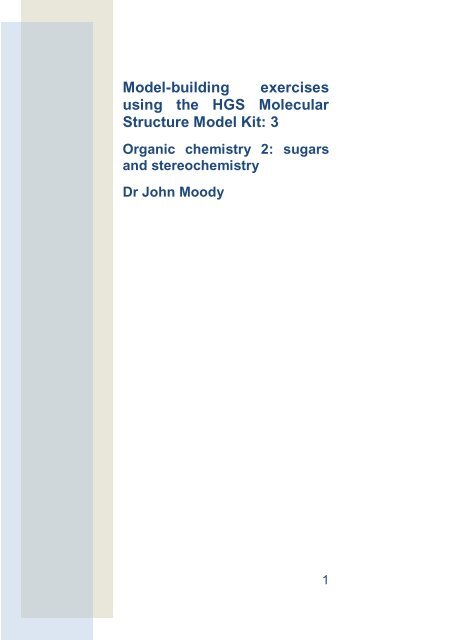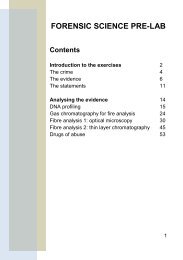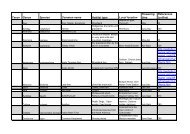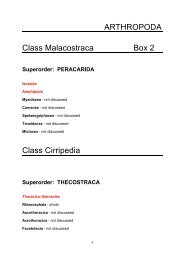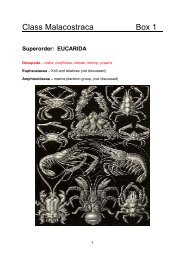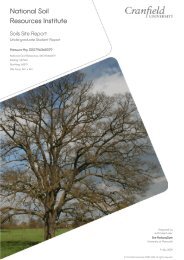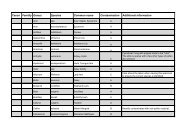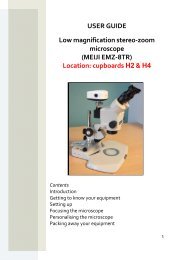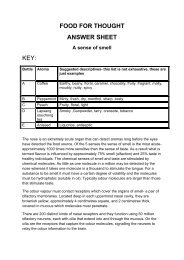Model-building exercises using the HGS Molecular Structure Model ...
Model-building exercises using the HGS Molecular Structure Model ...
Model-building exercises using the HGS Molecular Structure Model ...
You also want an ePaper? Increase the reach of your titles
YUMPU automatically turns print PDFs into web optimized ePapers that Google loves.
<strong>Model</strong>-<strong>building</strong> <strong>exercises</strong><br />
<strong>using</strong> <strong>the</strong> <strong>HGS</strong> <strong>Molecular</strong><br />
<strong>Structure</strong> <strong>Model</strong> Kit: 3<br />
Organic chemistry 2: sugars<br />
and stereochemistry<br />
Dr John Moody<br />
1
Organic chemistry 2: sugars<br />
and stereochemistry<br />
In biochemistry <strong>the</strong> term sugar<br />
refers to any of <strong>the</strong> simpler<br />
carbohydrates. This includes <strong>the</strong><br />
sort of sugar that we might put in<br />
our tea. Carbohydrates are organic<br />
molecules containing carbon,<br />
hydrogen and oxygen atoms (not to<br />
be confused with hydrocarbons).<br />
The aim of <strong>the</strong> model-<strong>building</strong><br />
<strong>exercises</strong> described here is to<br />
introduce you to <strong>the</strong> structures of<br />
some simple sugars that are of<br />
importance in life, and at <strong>the</strong> same<br />
time learn something about<br />
stereochemistry, an important<br />
concept in biochemistry. By <strong>building</strong><br />
<strong>the</strong> models you should also extend<br />
your knowledge of functional<br />
groups.<br />
Exercise 1: aldehydes and<br />
ketones<br />
N.B. It is assumed that you have<br />
already carried out <strong>the</strong><br />
Introduction to organic chemistry<br />
<strong>exercises</strong> before starting on <strong>the</strong><br />
<strong>exercises</strong> described here.<br />
First construct a model of propane<br />
(CH 3 CH 2 CH 3 ). The diagram on <strong>the</strong><br />
right and <strong>the</strong> expanded chemical<br />
formula should remind you of its<br />
structure. You can check on <strong>the</strong><br />
2
tables on <strong>the</strong> laminated sheet to<br />
make sure that you are <strong>using</strong> <strong>the</strong><br />
correct bond connectors.<br />
Now replace two of <strong>the</strong> hydrogen<br />
atoms on <strong>the</strong> first carbon with a<br />
double bonded oxygen, i.e. form a<br />
carbonyl group. Use a pair of<br />
curved blue bond connectors to do<br />
this.<br />
You have just made an aldehyde<br />
called propanal (CH 3 CH 2 CHO). Be<br />
careful not to confuse this with<br />
propanol, which is an alcohol.<br />
Propanal is an aldehyde because it<br />
contains an aldehyde group. Notice<br />
that <strong>the</strong> term aldehyde is used here<br />
to describe both <strong>the</strong> aldehyde group<br />
and organic compounds containing<br />
aldehyde groups.<br />
Have a look at your model. Like <strong>the</strong><br />
carboxyl group, introduced in <strong>the</strong><br />
Introduction to organic chemistry<br />
<strong>exercises</strong>, <strong>the</strong> aldehyde group is<br />
also flat (planar).<br />
Move <strong>the</strong> carbonyl group from <strong>the</strong><br />
first carbon to <strong>the</strong> second carbon.<br />
You will have to move two hydrogen<br />
atoms to <strong>the</strong> first carbon in<br />
exchange.<br />
You have now made an isomer of<br />
propanal called propanone.<br />
Propanone is an example of <strong>the</strong><br />
3
group of compounds called<br />
ketones. Once again <strong>the</strong> term<br />
ketone describes both <strong>the</strong> chemical<br />
group and compounds which<br />
contain ketone groups.<br />
Propanone is more commonly<br />
known by its trivial name, acetone.<br />
Acetone is a volatile solvent. If you<br />
have ever used nail-varnish<br />
remover you will know what it<br />
smells like! It is produced as a byproduct<br />
of <strong>the</strong> metabolic changes<br />
that occur in <strong>the</strong> human body during<br />
starvation, in diabetes mellitus and<br />
with a high fat diet. It may <strong>the</strong>n be<br />
possible to smell it on someone’s<br />
breath.<br />
4
Exercise 2: <strong>the</strong> simplest<br />
sugars of all<br />
To make a simple sugar, take your<br />
model of acetone and replace one<br />
of <strong>the</strong> hydrogen atoms on each of<br />
carbons 1 and 3 with a hydroxyl<br />
group. Use green bond connectors<br />
for <strong>the</strong> C-O bonds.<br />
The molecule you have just made a<br />
model of has <strong>the</strong> trivial name<br />
dihydroxyacetone. ‘di’ means two,<br />
so this is acetone with two hydroxyl<br />
groups. Its formal name is<br />
1,3-dihydroxy propan-2-one.<br />
Dihydroxyacetone can take part in<br />
Maillard reactions. These are <strong>the</strong><br />
reactions that lead to <strong>the</strong> browning<br />
of food during cooking (not <strong>the</strong><br />
blackening of food which is caused<br />
by burning!). Dihydroxyacetone is<br />
<strong>the</strong> active ingredient in many sunless<br />
tanning agents, where it reacts<br />
with proteins in <strong>the</strong> dead surface<br />
layers of <strong>the</strong> skin.<br />
(For a review on sunless tanning<br />
see Fu et al. (2004) Journal of <strong>the</strong><br />
American Academy of Dermatology<br />
50(5), 706-713.)<br />
Dihydroxyacetone is one of two 3<br />
carbon sugars, which are isomers<br />
of each o<strong>the</strong>r. You can convert<br />
dihydroacetone to <strong>the</strong> o<strong>the</strong>r 3<br />
carbon sugar, glyceraldehyde, by<br />
5
swapping <strong>the</strong> carbonyl group on<br />
carbon 2 for <strong>the</strong> hydroxyl group and<br />
a hydrogen atom from carbon 1.<br />
You can tell that you are dealing<br />
with isomers here because when<br />
you converted one molecule to <strong>the</strong><br />
o<strong>the</strong>r you did not add or remove<br />
any atoms or bonds.<br />
Dihydroxyacetone is a ketone,<br />
whereas glyceraldehyde, as its<br />
name implies, is an aldehyde.<br />
There are two broad classes of<br />
simple sugars, those that are<br />
ketones, which are called ketoses,<br />
and those that are aldehydes, which<br />
are called aldoses.<br />
How do we define a simple sugar?<br />
Simple sugars are a group of<br />
molecules which usually have <strong>the</strong><br />
same generic molecular formula,<br />
and which have similar properties.<br />
They form an homologous series<br />
(see Introduction to organic<br />
chemistry). The generic chemical<br />
formula for a simple sugar is<br />
(CH 2 O) n , where n is greater than or<br />
equal to 3.<br />
Have a look at your model of<br />
glyceraldehyde. Does it conform to<br />
<strong>the</strong> formula (CH 2 O) n ?<br />
In <strong>the</strong> representation of<br />
glyceraldehyde shown a couple of<br />
6
pages back <strong>the</strong> C-O bond on<br />
carbon 2 was shown with a<br />
‘squiggle’; you may have wondered<br />
why. It is shown this way because<br />
glyceraldehyde can have two<br />
different stereoisomers in which<br />
<strong>the</strong> configuration of <strong>the</strong> bonds on<br />
carbon 2 are different. On <strong>the</strong><br />
diagram on <strong>the</strong> right a wedgeshaped<br />
bond indicates that it is<br />
projecting out of <strong>the</strong> plane of <strong>the</strong><br />
page.<br />
Make a second molecule of<br />
glyceraldehye.<br />
Is it exactly <strong>the</strong> same as your first?<br />
If it is, <strong>the</strong>n what would you need to<br />
do to make it different? If it is not,<br />
<strong>the</strong>n what is different about it?<br />
You should be able to produce two<br />
models that are mirror images of<br />
each o<strong>the</strong>r. It is important to note<br />
that <strong>the</strong>se cannot be superimposed<br />
one on <strong>the</strong> o<strong>the</strong>r.<br />
Stereoisomers are defined as<br />
molecules with <strong>the</strong> same atoms and<br />
bonds, but where <strong>the</strong> arrangement<br />
(configuration) of <strong>the</strong> bonds in<br />
space is different.<br />
Look at carbon 2 in ei<strong>the</strong>r of your<br />
models. This carbon has four<br />
different chemical groups or<br />
7
atoms connected to it, unlike<br />
carbon 3 where two (hydrogen<br />
atoms) are <strong>the</strong> same.<br />
Any carbon atom like carbon 2 in<br />
glyceraldehyde can have two<br />
different configurations. These are<br />
called <strong>the</strong> ‘left-handed’ or ‘laevo’<br />
(from <strong>the</strong> Latin, laevus, meaning<br />
left) and <strong>the</strong> ‘right-handed’ or<br />
‘dextro’ (from <strong>the</strong> Latin, dexter,<br />
meaning right) configurations.<br />
Carbon 2 in glyceraldehyde is<br />
referred to as a an asymmetric<br />
carbon or chiral centre (from <strong>the</strong><br />
Greek, kheir, meaning hand).<br />
Does this really matter? In physical<br />
and chemical terms <strong>the</strong> answer is<br />
‘not very much’. Both stereoisomers<br />
of glyceraldehyde have <strong>the</strong> same<br />
physical and chemical properties,<br />
except for <strong>the</strong>ir interaction with<br />
plane polarised light, which <strong>the</strong>y<br />
rotate in opposite directions.<br />
However, when it comes to<br />
biochemistry <strong>the</strong> difference matters<br />
a great deal.<br />
The left-handed form of<br />
glyceraldehyde is indicated by<br />
writing L-glyceraldehyde, while <strong>the</strong><br />
right-handed form is indicated by<br />
writing D-glyceraldehyde, but how<br />
do we know which is which?<br />
8
There are rules for <strong>the</strong> naming of<br />
stereoisomers, which we are not<br />
going to go into in detail here.<br />
However, if we know how to tell D-<br />
and L-glyceraldehyde apart we can<br />
use this to help us with o<strong>the</strong>r simple<br />
sugars. This is made easier if we<br />
use Fischer projections.<br />
*<br />
9
Take one your models of<br />
glyceraldehyde and place it on a<br />
piece of white paper with carbon 1<br />
(<strong>the</strong> one in <strong>the</strong> aldehyde group) at<br />
<strong>the</strong> top, and with <strong>the</strong> horizontal<br />
bonds projecting out from <strong>the</strong><br />
paper. Conversely <strong>the</strong> vertical<br />
bonds must project in towards <strong>the</strong><br />
paper.<br />
Now look down from above and<br />
draw a diagram showing carbon 2<br />
and <strong>the</strong> four bonds coming of it. It<br />
should look something like a plus<br />
sign. Label each of <strong>the</strong> arms of your<br />
+ with <strong>the</strong> formula for <strong>the</strong> chemical<br />
group on that arm, e.g. H, if it is just<br />
a hydrogen atom, or CHO for <strong>the</strong><br />
aldehyde group.<br />
Follow <strong>the</strong> same procedure for your<br />
o<strong>the</strong>r model, and when you have<br />
finished put your two drawings side<br />
by side. How do <strong>the</strong>y compare?<br />
Hopefully <strong>the</strong>y look like <strong>the</strong><br />
diagrams shown below.<br />
10
Glyceraldehyde is used as a<br />
configurational standard for o<strong>the</strong>r<br />
simple sugars. The Fischer<br />
projections make it clear that <strong>the</strong><br />
two stereoisomers of glyceraldehyde<br />
are mirror images of each<br />
o<strong>the</strong>r. Pairs of stereoisomers that<br />
are mirror images of each o<strong>the</strong>r are<br />
called enantiomers.<br />
Exercise 3: ribose and o<strong>the</strong>r<br />
pentoses<br />
The two stereoisomers of<br />
glyceraldehyde, and dihydroxyacetone<br />
are <strong>the</strong> only examples of<br />
three carbon (3C) sugars (trioses).<br />
As <strong>the</strong> number of carbons increases<br />
<strong>the</strong> range of possibilities increases<br />
because <strong>the</strong> number of chiral<br />
carbons increases. With 5C sugars<br />
(pentoses) <strong>the</strong>re are two structural<br />
isomers (aldopentose and ketopentose)<br />
and a total of 12<br />
stereoisomers!<br />
The 5C sugar D-ribose is an<br />
important cellular component. For<br />
example, it forms part of <strong>the</strong><br />
structure of ribonucleic acids. The<br />
structure of a transfer RNA, tRNA,<br />
is shown on <strong>the</strong> right. D-ribose is<br />
one of 8 different stereoisomeric<br />
aldopentoses. The aim of this<br />
exercise is to first build a model of<br />
D-ribose, and <strong>the</strong>n, <strong>using</strong> this<br />
11
model, to explore <strong>the</strong> relationships<br />
between <strong>the</strong> different stereoisomers<br />
of D-ribose.<br />
Take your model of D-glyceraldehyde<br />
and leng<strong>the</strong>n it by adding<br />
two hydroxymethylene groups<br />
between carbons 1 and 2 (taking<br />
carbon 1 to <strong>the</strong> one in <strong>the</strong> aldehyde<br />
group).<br />
You should now have a model of an<br />
aldopentose: ‘aldo’ meaning <strong>the</strong>re is<br />
an aldehyde group at one end;<br />
‘pent’ meaning that <strong>the</strong>re are 5<br />
carbons; and ‘ose’ indicating that it<br />
is a sugar. Every carbon except <strong>the</strong><br />
one involved in <strong>the</strong> aldehyde group<br />
should have a hydroxyl group<br />
attached to it.<br />
It may be an aldopentose, but is it<br />
<strong>the</strong> one we set out to make,<br />
D-ribose? Well one thing is for sure<br />
at this stage, if you have followed<br />
<strong>the</strong> instructions. The model you<br />
have made must be of a<br />
D-aldopentose. Why? If you draw a<br />
Fischer projection of your model<br />
you should be able to see why.<br />
Follow <strong>the</strong> instructions below<br />
carefully; it is quite easy to go<br />
wrong!<br />
First arrange <strong>the</strong> model so<br />
that <strong>the</strong> carbon skeleton lies as a<br />
12
linear zigzag, with <strong>the</strong> aldehyde<br />
group facing away from you.<br />
Take each of <strong>the</strong> four chiral<br />
carbons in turn – start with<br />
carbon 4.<br />
Place <strong>the</strong> model on a piece<br />
of white paper so that <strong>the</strong><br />
horizontal bonds on carbon 4<br />
project away from <strong>the</strong> paper.<br />
Look down on <strong>the</strong> model<br />
from above and make a diagram<br />
similar to those you made for D- and<br />
L-glyceraldehyde.<br />
Do <strong>the</strong> same thing with <strong>the</strong><br />
next chiral carbon (carbon 3). This<br />
will entail turning <strong>the</strong> model over<br />
so that <strong>the</strong> horizontal bonds on<br />
<strong>the</strong> chiral carbon project away<br />
from <strong>the</strong> paper.<br />
Finally do <strong>the</strong> same thing <strong>the</strong><br />
last chiral carbon (carbon 2).<br />
A Fischer projection of D-ribose is<br />
shown to <strong>the</strong> right. How does yours<br />
compare to this? You can tell if your<br />
model is a D-aldopentose if <strong>the</strong><br />
configuration of <strong>the</strong> chiral carbon<br />
(carbon 4) fur<strong>the</strong>st away from<br />
aldehyde group matches that of<br />
D-glyceraldehdye. Remember that<br />
glyceraldehyde is used as a<br />
configurational standard for o<strong>the</strong>r<br />
simple sugars. We can tell whe<strong>the</strong>r<br />
13<br />
D-ribose
a simple sugar is <strong>the</strong> D- or <strong>the</strong> L-<br />
isomer by comparing its Fischer<br />
projection with those of D- and L-<br />
glyceraldehyde.<br />
What about <strong>the</strong> rest of your model;<br />
how does it compare with D-ribose?<br />
There are three chiral carbons in<br />
D-ribose and <strong>the</strong>re are two possible<br />
configurations of <strong>the</strong> bonds round<br />
each of <strong>the</strong>se giving 2 3 (i.e. eight)<br />
different permutations. If necessary<br />
adjust <strong>the</strong> configuration of carbons<br />
2 and 3 so that <strong>the</strong>y match those of<br />
D-ribose (i.e. swap <strong>the</strong> hydroxyl<br />
groups for <strong>the</strong> hydrogen atoms).<br />
Now that you have got a model of<br />
D-ribose, you can have a go at<br />
converting it to some of <strong>the</strong> o<strong>the</strong>r<br />
aldopentoses. First change <strong>the</strong><br />
configuration of carbon 2 (swap <strong>the</strong><br />
hydroxyl for <strong>the</strong> hydrogen). You<br />
have converted from D-ribose to<br />
D-arabinose. D-arabinose is not <strong>the</strong><br />
mirror image of D-ribose, so it is not<br />
its enantiomer.<br />
Where you have two sugars that<br />
differ only in <strong>the</strong> configuration round<br />
one carbon atom <strong>the</strong>y are referred<br />
to as epimers. A more general<br />
term, diastereoisomers, is also<br />
used to describe stereoisomers that<br />
are not enantiomers, i.e. not mirror<br />
images of each o<strong>the</strong>r.<br />
D-arabinose<br />
14
D-arabinose is not common in<br />
nature. L-arabinose is much more<br />
common. It is found in plant cell<br />
walls and is a component of <strong>the</strong><br />
plant-derived gelling agent, pectin,<br />
which is often used in jam.<br />
Swap <strong>the</strong> configuration around<br />
carbon 4. You now have L-xylose.<br />
L-xylose is not found in nature, but<br />
D-xylose is a common component<br />
of plant cell walls. It is also used to<br />
test for malabsorption problems in<br />
<strong>the</strong> small intestine. The levels of<br />
D-xylose in blood and urine are<br />
measured before and after drinking<br />
a solution of D-xylose.<br />
If you swap <strong>the</strong> configuration of <strong>the</strong><br />
last chiral carbon, number 3, you<br />
will make L-ribose, <strong>the</strong> mirror<br />
image of D-ribose, i.e. its<br />
enantiomer.<br />
Finally, if you swap <strong>the</strong><br />
configuration of carbon 4 back<br />
again you will make D-lyxose,<br />
which is not found in nature.<br />
So far in this exercise you have only<br />
made aldopentoses, aldoses with<br />
five carbons, but remember that<br />
<strong>the</strong>re are also ketopentoses, i.e.<br />
five carbon sugars with a ketone<br />
group ra<strong>the</strong>r than an aldehyde<br />
group.<br />
L-xylose<br />
L-ribose<br />
15
Take your model of D-lyxose and<br />
swap <strong>the</strong> double-bonded oxygen<br />
from carbon 1 with <strong>the</strong> hydroxyl<br />
group and hydrogen atom from<br />
carbon 2.<br />
You now have a model of a<br />
ketopentose. This one is called<br />
D-xylulose. Ketopentoses are<br />
named by inserting ‘ul’ into <strong>the</strong><br />
name of <strong>the</strong> most closely related<br />
aldopentose.<br />
In humans a genetic deficiency in<br />
<strong>the</strong> L-xylulose reductase leads to<br />
<strong>the</strong> appearance of high<br />
concentrations of L-xylulose, <strong>the</strong><br />
enantiomer of D-xylulose in <strong>the</strong><br />
urine, a condition known as<br />
pentosuria (from ‘pentose’,<br />
meaning ‘five carbon sugar’, and<br />
‘uria’ meaning ‘in <strong>the</strong> urine’).<br />
Have a look at your model. How<br />
many chiral carbons are <strong>the</strong>re?<br />
How many different stereoisomeric<br />
ketopentoses must <strong>the</strong>re be?<br />
D-lyxose<br />
D-xylulose<br />
What would you have to do to<br />
convert it to D-xylulose?<br />
16
Exercise 4: glucose and<br />
fructose<br />
In animals D-glucose is an<br />
important circulating metabolic fuel.<br />
Nervous tissue, for example, is<br />
normally completely reliant on it.<br />
There is at least some truth in <strong>the</strong><br />
old advertising slogan ‘a Mars a day<br />
helps you work, rest and play’.<br />
D-glucose is one of twelve 6C<br />
sugars, and each of <strong>the</strong>se has a D-<br />
and an L- form making 24<br />
altoge<strong>the</strong>r. In nature it is mostly <strong>the</strong><br />
D-forms that are found. D-glucose is<br />
an aldose or more specifically an<br />
aldohexose.<br />
Construct a model of D-glucose<br />
<strong>using</strong> <strong>the</strong> Fischer projection to <strong>the</strong><br />
right as a guide. Make sure that <strong>the</strong><br />
configuration of each of <strong>the</strong> four<br />
chiral (asymmetric) carbons is<br />
correct. As before, focus on each of<br />
<strong>the</strong> four chiral carbons in turn, and,<br />
when drawing <strong>the</strong> Fischer projection<br />
for that particular carbon, ensure<br />
that that <strong>the</strong> horizontal bonds<br />
project away from <strong>the</strong> page. It<br />
may be useful at this stage to label<br />
carbon 1 and carbon 5; <strong>the</strong>re are<br />
some labels in <strong>the</strong> box that you can<br />
use.<br />
The model that you have made has<br />
an essentially linear carbon<br />
17
skeleton. However, in a solution in<br />
water most of <strong>the</strong> D-glucose would<br />
be present in a cyclic form. When<br />
an aldehyde or a ketone reacts with<br />
an alcohol new chemical groups are<br />
formed, called a hemiacetal and a<br />
hemiketal, respectively. Since<br />
simple sugars are both aldehydes<br />
(or ketones) and alcohols (<strong>the</strong>y<br />
contain two or more hydroxyl<br />
groups) at <strong>the</strong> same time, many can<br />
react with <strong>the</strong>mselves to form cyclic<br />
hemiacetals (or hemiketals).<br />
There are two types of cyclic (ring)<br />
forms found in simple sugars: 5<br />
membered rings (furanoses) and 6<br />
membered rings (pyranoses).<br />
Glucose can form both of <strong>the</strong>se, but<br />
is more likely to be found in a<br />
pyranose form.<br />
Make a pyranose form of D-glucose<br />
by first swinging <strong>the</strong> oxygen of <strong>the</strong><br />
hydroxyl group on carbon 5<br />
round towards <strong>the</strong> aldehyde<br />
carbon (carbon 1) in your model.<br />
The oxygen in <strong>the</strong> hydroxyl group<br />
has a slight excess of electrons<br />
(because of <strong>the</strong> electronegativity of<br />
oxygen: see Introduction to<br />
chemical bonding).<br />
hemiacetal<br />
group<br />
18
It is able to donate a pair of<br />
electrons towards carbon 1 (which<br />
has a slight deficit of electrons<br />
because of its double bond with an<br />
oxygen atom. This starts off a set of<br />
electron movements (bond<br />
breakage and formation) which is<br />
represented in <strong>the</strong> diagram below.<br />
This sort of electron redistribution<br />
is what we mean when we talk<br />
about a chemical reaction.<br />
The little red arrows in <strong>the</strong> diagram<br />
represent movements of pairs of<br />
electrons.<br />
Try doing <strong>the</strong> rearrangements<br />
shown in <strong>the</strong> diagram with your<br />
model. You should end up with a<br />
ring containing 5 carbon atoms and<br />
1 oxygen atom. You can replace <strong>the</strong><br />
green bond connectors representing<br />
C-O bonds in <strong>the</strong> ring with white<br />
connectors because this better<br />
represents <strong>the</strong> lengths of <strong>the</strong>se<br />
particular C-O bonds.<br />
19
Look at your model from <strong>the</strong> side<br />
with <strong>the</strong> oxygen atom in <strong>the</strong> ring<br />
facing away from you and to <strong>the</strong><br />
right, with carbon 1 to <strong>the</strong> right, and<br />
with carbon 6 sticking up. (It may<br />
take you a while to work out which<br />
is carbon 1 if you did not label it<br />
earlier!) You should hopefully be<br />
able to arange it to look something<br />
like <strong>the</strong> diagram.<br />
There may well be some<br />
differences, however, in <strong>the</strong><br />
configuration of <strong>the</strong> molecule, or in<br />
its conformation, or in both its<br />
configuration and conformation.<br />
Look at carbon 1. This is <strong>the</strong> one<br />
that was part of <strong>the</strong> aldehyde group.<br />
There are now four different<br />
substituents on this carbon, so it is<br />
now asymmetric; in <strong>the</strong> formation of<br />
<strong>the</strong> ring it has become a chiral<br />
carbon. There are, <strong>the</strong>refore, two<br />
possible configurations of <strong>the</strong> bonds<br />
round this carbon.<br />
These are called <strong>the</strong> (alpha) and<br />
(beta) anomers, and <strong>the</strong> chiral<br />
carbon created when <strong>the</strong> ring forms<br />
is called <strong>the</strong> anomeric carbon. The<br />
perspective views that are often<br />
used to represent <strong>the</strong>se are called<br />
Haworth projections.<br />
20
The diagrams on <strong>the</strong> previous page<br />
show a conformation called a<br />
‘chair’ form, because of its vague<br />
resemblance to chair. An alternative<br />
conformation is a ‘boat’ form,<br />
again because of its vague<br />
resemblance to a boat!<br />
Carefully rotate <strong>the</strong> C-C and C-O<br />
bonds in <strong>the</strong> ring in order to switch<br />
<strong>the</strong> conformation of your model<br />
between chair and boat forms.<br />
In a solution of D-glucose, at any<br />
one time, less than 1% of <strong>the</strong><br />
molecules are in <strong>the</strong> open chain<br />
form. Most of <strong>the</strong> molecules are in<br />
<strong>the</strong> 6-membered (pyranose) ring<br />
form with about 2/3 having <strong>the</strong><br />
configuration and about 1/3 <strong>the</strong><br />
configuration. A tiny amount of<br />
<strong>the</strong> 5-membered (furanose) ring<br />
forms would also be present.<br />
Try making a furanose form of<br />
D-glucose with your model. How<br />
about 4-membered or 7-membered<br />
rings – are <strong>the</strong>se possible? Be<br />
careful not to break any bond<br />
connectors trying to make <strong>the</strong>m!<br />
Remake <strong>the</strong> pyranose form of<br />
D-glucose. From its structure, and<br />
what you learned in <strong>the</strong><br />
Introduction to chemical<br />
bonding, do you think it would be<br />
soluble in water?<br />
21
Exercise 5: disaccharides<br />
Does any of this matter? When you<br />
are dealing with just simple sugars<br />
in solution <strong>the</strong> answer is ‘not a lot’.<br />
However, if we start assembling<br />
sugars toge<strong>the</strong>r to form larger<br />
structures, like those found in living<br />
organisms, it becomes very<br />
important indeed, as hopefully you<br />
will see.<br />
Simple sugars like D-ribose and<br />
D-glucose are called monosaccharides<br />
(‘mono’ meaning one).<br />
If two monosaccharides are joined<br />
toge<strong>the</strong>r we have a disaccharide<br />
(‘di’ meaning two). Several<br />
monosaccharides joined toge<strong>the</strong>r<br />
are called oligosaccharides (‘oligo’<br />
meaning few), while many monosaccharides<br />
joined toge<strong>the</strong>r are<br />
called polysaccharides (‘poly’<br />
meaning much).<br />
Table sugar or sucrose is an<br />
example of a disaccharide, as is<br />
milk sugar or lactose.<br />
The aim of this exercise is to<br />
explore <strong>the</strong> ways in which simple<br />
sugars can link toge<strong>the</strong>r, and <strong>the</strong><br />
possible consequences of this for<br />
<strong>the</strong> properties of polysaccharides.<br />
22
Make two models of D-glucose in its<br />
6-membered ring form, each with<br />
<strong>the</strong> anomeric carbon in <strong>the</strong> <br />
configuration (-D-glucopyranose).<br />
The disaccharide cellobiose, which<br />
is a breakdown product of <strong>the</strong> plant<br />
cell wall polysaccharide, cellulose,<br />
consists of two glucose units<br />
(residues) linked toge<strong>the</strong>r.<br />
Carbon 1 in one molecule is linked<br />
via an oxygen atom to carbon 4 of<br />
<strong>the</strong> o<strong>the</strong>r. Since <strong>the</strong> D-glucose is in<br />
its configuration such a linkage is<br />
called a (14) bond. Bonds like<br />
this between sugar residues are<br />
called glycosidic links. They are<br />
formed in a reaction in which a<br />
molecule of water is produced.<br />
Such reactions are called<br />
dehydration (or more generally,<br />
condensation) reactions.<br />
Join your two D-glucose molecules<br />
toge<strong>the</strong>r <strong>using</strong> <strong>the</strong> diagram below<br />
as a guide.<br />
23
Note, that in <strong>the</strong> diagram of<br />
cellobiose on <strong>the</strong> last page bonds<br />
shown with wedge shapes are<br />
directed out of <strong>the</strong> plane of <strong>the</strong> page<br />
whereas bonds shown with dashed<br />
lines are directed into <strong>the</strong> plane of<br />
<strong>the</strong> page.<br />
Have a look at your model of<br />
cellobiose. One of <strong>the</strong> glucose<br />
residues is now locked in <strong>the</strong> ring<br />
form (<strong>the</strong> one where carbon 1 is<br />
involved in <strong>the</strong> glycosidic link).<br />
However, <strong>the</strong> o<strong>the</strong>r can still open up<br />
into <strong>the</strong> open chain form. The<br />
aldehyde group in this glucose<br />
residue can reform, and potentially<br />
take part in chemical reactions,<br />
whereas with <strong>the</strong> o<strong>the</strong>r residue this<br />
cannot happen.<br />
Sucrose consists of a glucose<br />
residue and a fructose residue<br />
joined toge<strong>the</strong>r by an (12)<br />
linkage. Recall that fructose is a<br />
ketose, and that it is carbon 2 that is<br />
part of <strong>the</strong> ketone group in ketoses,<br />
i.e. it is carbon 2 that is <strong>the</strong><br />
anomeric carbon in ketoses. In<br />
this case <strong>the</strong> glycosidic link locks<br />
both residues into <strong>the</strong>ir ring forms.<br />
24
Cellulose is a polysaccharide<br />
consisting of many glucose<br />
residues connected toge<strong>the</strong>r in <strong>the</strong><br />
same way as that found in<br />
cellobiose.<br />
Amylose (a component of starch)<br />
is also a polysaccharide consisting<br />
of many glucose residues<br />
connected toge<strong>the</strong>r, but whereas<br />
cellulose has great tensile strength,<br />
and so is suitable as a structural<br />
material for plant cell walls, amylose<br />
has no tensile strength and is used<br />
a storage material (for storing <strong>the</strong><br />
metabolic fuel glucose).<br />
In both cases <strong>the</strong> glucose residues<br />
are mostly held toge<strong>the</strong>r by 14<br />
links, so why are <strong>the</strong>ir properties so<br />
different? The answer lies in <strong>the</strong><br />
detail of <strong>the</strong> glycosidic links. In<br />
cellulose <strong>the</strong>y are (14) links, but<br />
in amylose <strong>the</strong>y are (14) links.<br />
Why should this make a difference?<br />
25
Take your model of cellobiose; this<br />
represents a small section of <strong>the</strong><br />
structure of cellulose. Make sure<br />
that both glucose residues are in<br />
<strong>the</strong> chair conformation. Then turn<br />
second glucose residue (via rotation<br />
round <strong>the</strong> glycosidic link) until it is<br />
oriented 180° relative to <strong>the</strong> first<br />
residue. Once you have done this<br />
hold your model so that it<br />
corresponds to <strong>the</strong> diagram below.<br />
Once you have your model in this<br />
position you should be able to form<br />
a pair of hydrogen bonds (see<br />
Introduction to chemical<br />
bonding) between <strong>the</strong> two glucose<br />
residues, as shown in <strong>the</strong> diagram.<br />
It would be a good idea to use <strong>the</strong><br />
yellow bond connectors to make<br />
<strong>the</strong>se bonds so that you do not lose<br />
track of which are hydrogen bonds.<br />
What effect does <strong>the</strong> formation of<br />
<strong>the</strong>se hydrogen bonds have on your<br />
model?<br />
26
In amylose, where <strong>the</strong> glucose<br />
residues are joined by (14)<br />
linkages <strong>the</strong>re is no strong<br />
hydrogen bonding between<br />
adjacent glucose residues. As a<br />
consequence <strong>the</strong> structure is less<br />
rigid.<br />
27
Glossary of terms<br />
Acetone<br />
The simplest possible ketone. Its<br />
systematic name is propanone.<br />
Aldehye<br />
An organic compound with a<br />
terminal carbonyl group. The term<br />
aldehyde group is also applied to<br />
<strong>the</strong> terminal carbonyl itself.<br />
Aldopentose<br />
A pentose (5C sugar) with an<br />
aldehyde group.<br />
Amylose<br />
A linear polymer of glucose found in<br />
plants. Toge<strong>the</strong>r with amylopectin,<br />
which is a branched polymer of<br />
glucose, amylose is a major<br />
component of starch.<br />
Anomer<br />
A type of stereoisomer generated in<br />
<strong>the</strong> cyclisation of simple sugars. In<br />
<strong>the</strong>ir ring forms simple sugars have<br />
a new chiral carbon, and <strong>the</strong>re are<br />
two possible configurations of<br />
bonds round this. Anomers could<br />
also be described as epimers or<br />
diastereoisomers.<br />
Asymmetric carbon<br />
An asymmetric carbon has four<br />
different chemical groups attached<br />
to it. As a result it becomes chiral.<br />
28
Cellobiose<br />
A disaccharide consisting of two<br />
D-glucose molecules linked by a<br />
(14) glycosidic linkage.<br />
Cellulose<br />
A structural polymer of glucose,<br />
containing predominantly (14)<br />
linkages.<br />
Chiral<br />
A molecule or component of a<br />
molecule is said to be chiral if it<br />
cannot superimpose on its mirror<br />
image.<br />
Condensation<br />
A chemical reaction in which two<br />
molecules combine with <strong>the</strong> loss of<br />
a small molecule. If <strong>the</strong> small<br />
molecule is water <strong>the</strong>n this is<br />
referred to as a dehydration<br />
reaction.<br />
Dehydration<br />
A specific type of condensation<br />
reaction in which a molecule of<br />
water is eliminated.<br />
Diastereoisomer<br />
Any stereoisomer that is not an<br />
enantiomer.<br />
Disaccharide<br />
Two simple sugars (monosaccharides)<br />
linked by a glycosidic<br />
linkage.<br />
29
Enantiomer<br />
A stereoisomer that is <strong>the</strong> mirror<br />
image of ano<strong>the</strong>r stereoisomer.<br />
Epimer<br />
A stereoisomer that differs from<br />
ano<strong>the</strong>r stereoisomer in <strong>the</strong><br />
configuration of one chiral carbon.<br />
Fischer projection<br />
A 2D representation of a 3D<br />
molecule obtained by projection<br />
onto a surface.<br />
Furanose<br />
This is used to describe cyclic forms<br />
of simple sugars with 5-membered<br />
rings.<br />
Glyceraldehyde<br />
A triose monosaccharide (3 carbon<br />
sugar) that is <strong>the</strong> simplest of all <strong>the</strong><br />
aldoses.<br />
Haworth projection (perspective)<br />
A perspective view used to<br />
represent different stereoisomers of<br />
simple sugars.<br />
Hexose<br />
A 6C simple sugar (monosaccharide).<br />
Ketone<br />
An organic compound containing a<br />
carbonyl group linked to two o<strong>the</strong>r<br />
carbon atoms, i.e. not a terminal<br />
carbonyl. The term ketone group is<br />
also applied to <strong>the</strong> carbonyl itself.<br />
30
Ketopentose<br />
A pentose (5C sugar) with a ketone<br />
group.<br />
Lactose<br />
A disaccharide consisting of<br />
-D-galactose and -D-glucose<br />
linked by a (14) glycosidic<br />
linkage<br />
Monosaccharide<br />
A simple sugar.<br />
Oligosaccharide<br />
Several simple sugars (monosaccharides)<br />
linked by glycosidic<br />
linkages.<br />
Pentose<br />
A 5C simple sugar (monosaccharide).<br />
Pentosuria<br />
An in-born error of metabolism<br />
which results in high levels of <strong>the</strong><br />
pentose xylulose in <strong>the</strong> urine. It is<br />
caused by a lack or deficiency in<br />
<strong>the</strong> enzyme L-xylulose reductase.<br />
Polymer<br />
Large molecules make up of many<br />
repeating units called monomers. In<br />
biological molecules <strong>the</strong> monomeric<br />
units once incorporated into <strong>the</strong><br />
polymer as often referred to as<br />
residues.<br />
31
Polysaccharide<br />
Many simple sugars (monosaccharides)<br />
linked by glycosidic<br />
linkages.<br />
Pyranose<br />
This is used to describe cyclic forms<br />
of simple sugars with 6-membered<br />
rings.<br />
Residues<br />
This is used to describe repeating<br />
units in a polymer after <strong>the</strong>ir<br />
incoproration into <strong>the</strong> polymer.<br />
(Configurational) stereoisomer<br />
An isomer that contains <strong>the</strong> same<br />
atoms and connections between<br />
<strong>the</strong>m as ano<strong>the</strong>r molecule, but with<br />
a different arrangement of <strong>the</strong>se<br />
bonds in space.<br />
Sucrose<br />
A disaccharide consisting of<br />
-D-glucose in a pyranose ring and<br />
-D-fructose in a furanose ring,<br />
linked by a (12) glycosidic<br />
linkage.<br />
Triose<br />
A three carbon simple sugar<br />
(monosaccharide). There are only<br />
two: glyceraldehyde and<br />
dihydroxyacetone.<br />
32
For illustrations labelled * <strong>the</strong><br />
following applies.<br />
Permission is granted to copy,<br />
distribute and/or modify this<br />
document under <strong>the</strong> terms of <strong>the</strong><br />
GNU Free Documentation License,<br />
Version 1.2 or any later version<br />
published by <strong>the</strong> Free Software<br />
Foundation; with no Invariant<br />
Sections, no Front-Cover Texts,<br />
and no Back-Cover Texts.<br />
33


